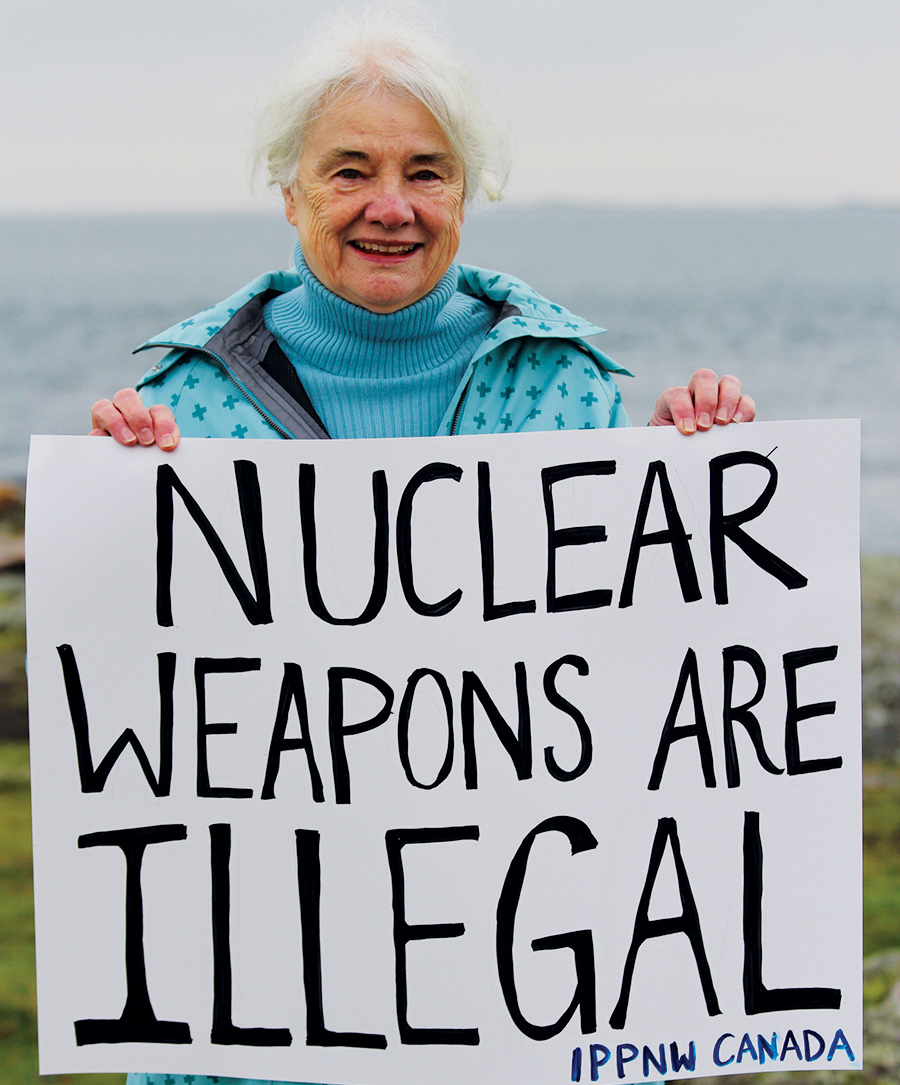Dr Mary-Wynne Ashford (née Moar), 1939–2022

Dr Mary-Wynne Ashford was born on 17 March 1939 in Indian Head, Saskatchewan. She passed away peacefully on 19 November 2022 in Victoria, British Columbia, with family at her side. A retired family and palliative care physician in Victoria and retired associate professor at the University of Victoria, Mary-Wynne was adamant that a physician’s role went far beyond caring for individual patients. She believed that advocating for peace and the elimination of nuclear weapons was part of a doctor’s duty of care.
For 37 years Mary-Wynne wrote and spoke internationally about peace and disarmament. She was co-president of International Physicians for the Prevention of Nuclear War (IPPNW) from 1998 to 2002 (which won the Nobel Peace Prize in 1985) and president of Canadian Physicians for the Prevention of Nuclear War from 1988 to 1990. She led two IPPNW delegations to North Korea, in 1999 and 2000. Her award-winning book, Enough Blood Shed: 101 Solutions to Violence, Terror and War, has been translated into Japanese and Korean. She won many awards, including the Queen’s medal on two occasions, the Gandhi Peace Prize in 1997, the Dr Cam Coady Medal of Excellence from Doctors of BC in 2019, and, with Dr Jonathan Down, the 2019 Distinguished Achievement Award from Canadians for a Nuclear Weapons Convention. She recognized the vital role of women as peace activists and in 2018 joined 1200 women from around the world to walk across the Reunification Bridge to a peace park in the demilitarized zone between North and South Korea. In 2021 she developed and taught an online course, Global Solutions for Peace, Equality, and Sustainability, sponsored by Next Gen U and IPPNW Canada. She nurtured an extensive network of international connections, and her ability to form strong relationships was a hallmark feature of her character.
The third of four children born to Jack Moar (a bush pilot, inventor, and entrepreneur) and Kitty Moar (a writer, teacher, artist, and community organizer), Mary-Wynne inherited a sense of boundless energy and optimism, and the belief that she had no limits. She was clever and confident, and she connected with people in a deep and meaningful way. At the University of Alberta, she earned a BSc in home economics and a BEd. In 1981 she graduated from the University of Calgary as a doctor of medicine, and in 1997 she earned her PhD in education from Simon Fraser University.
She married the late Dr David Ashford and was the mother of three (Karen, Graham, and Patrick). As a volunteer with the Calgary Zoo, she was foster mother to two baby orangutans and a polar bear cub, capturing the activity of those years in a regular column for the Calgary Herald titled “Out of My Tree.” Before enrolling in medical school, she studied music theory, singing, French, creative writing, and Shakespearean theatre. After completing her medical training and moving to Victoria, she married Dr Russell Davidson, adding four stepchildren (Katyann, Victoria, Gillian, and Emma) to the warm circle of family. She was grandmother to 10 grandchildren.
A passion for the arts infused her life. She performed in many drama and theatre productions, and her involvement in the Gettin’ Higher Choir and the Community Choir Leadership Training program continued until her death. She was renowned for her sewing skills, especially her handcrafted puppets. Recently she created puppets representing famous female social activists for the University of Victoria Faculty of Education and several special therapy puppets used to assist Syrian refugee children in telling their stories and settling in more easily in Canada.
For decades, Mary-Wynne collaborated with members of the Bahá’í Faith on issues of global peace, prosperity, and the advancement of women. In 2008 she formally joined the Bahá’í Faith and was an active member of the community, serving on institutions and promoting the teachings, particularly those that elaborated on aspects of world peace and global governance.
Mary-Wynne never lost hope that the world would one day be nuclear weapons–free. She was one of the most inspirational and influential leaders of our time.
—Jonathan Down, MD, FRCPC
Victoria
hidden
 |
| This work is licensed under a Creative Commons Attribution-NonCommercial-NoDerivatives 4.0 International License. |
